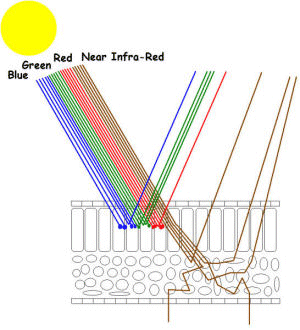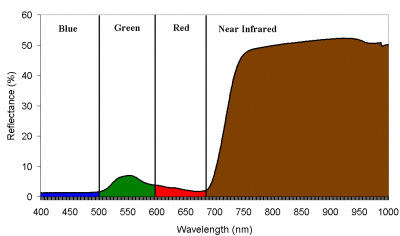Supplement - Vegetation Spectral Signature
Vegetation Spectral Signature
Vegetation covers a large portion of the Earth's land surface. Its role on the regulation of the global temperature, absorption of CO2 and other important functions, make it a land cover type of great significance and interest. Remote sensing can take advantage of the particular manner that vegetation reflects the incident electromagnetic energy and obtain information about the vegetation.

Under the upper epidermis (the thin layer of cells that forms the top surface of the leaf) there are primarily two layers of cells. The top one is the palisade parenchyma and consists of elongated cells, tightly arranged in a vertical manner. In this layer resides most of the chlorophyll, a protein that is responsible for capturing the solar energy and power the process of photosynthesis. The lower level is the spongy parenchyma, consisting of irregularly shaped cells, with a lot of air spaces between them, in order to allow the circulation of gases.
In addition to chlorophyll, the palisade parenchyma contains other pigments, such as carotenoids, anthocyanins and others, which are also responsible for the absorption of light. Because of those pigments, most of the visible electromagnetic energy is absorbed, especially in the blue and red region. Absorption in the green regions is slightly weaker, which is why vegetation appears green to our eyes. As a result, very little energy escapes the palisade parenchyma and is reflected back towards the sky. On the other hand, near infrared (NIR) energy is not affected by those pigments and almost completely penetrates the palisade parenchyma. When it reaches the spongy parenchyma, the presence of air spaces causes the refraction of the NIR energy in various directions. This results in approximately half the energy exiting the leaf from the lower epidermis and the other half from the top epidermis, towards the sky.
Remote sensors that record the reflected energy in the visible and near-infrared regions of the spectrum, will record a very weak signal in the blue and red regions, slightly stronger in the green and very strong in the near-infrared. If the strength of the signals for each region is displayed in a graph, it will look similar to the following figure:

The combination of low visible reflectance and high near-infrared reflectance is unique for most vegetation types and that is why it is known as the vegetation spectral signature.
